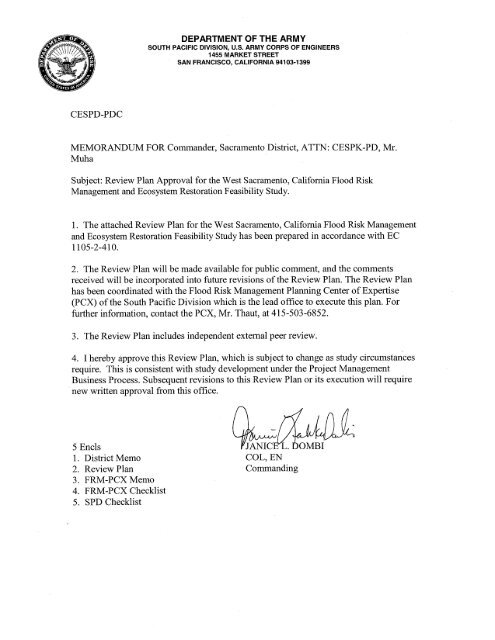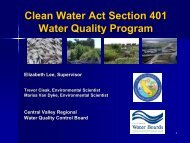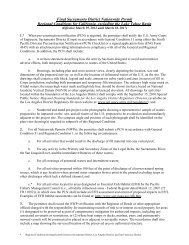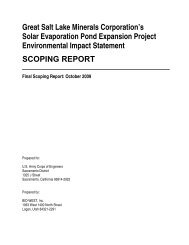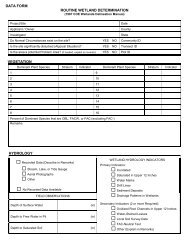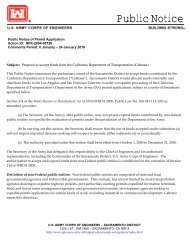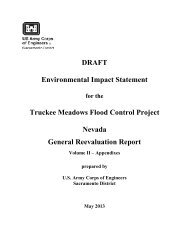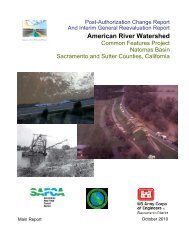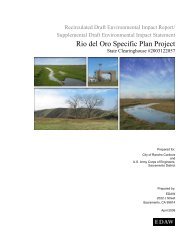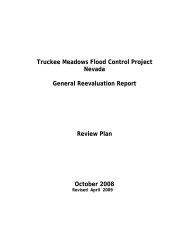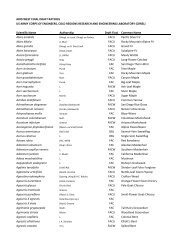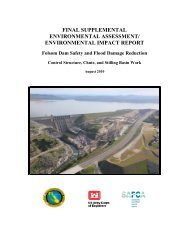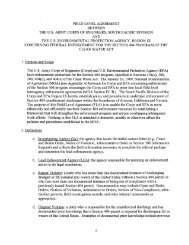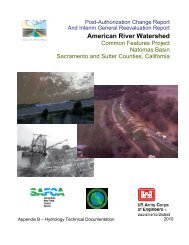Final Approved Review Plan - Sacramento District - U.S. Army
Final Approved Review Plan - Sacramento District - U.S. Army
Final Approved Review Plan - Sacramento District - U.S. Army
You also want an ePaper? Increase the reach of your titles
YUMPU automatically turns print PDFs into web optimized ePapers that Google loves.
REVIEW PLAN<br />
WEST SACRAMENTO, CALIFORNIA<br />
FLOOD RISK MANAGEMENT AND ECOSYSTEM RESTORATION<br />
GENERAL REEVALUATION REPORT<br />
SACRAMENTO DISTRICT<br />
MARCH 2009<br />
Revision 1 – N/A<br />
FRM-PCX <strong>Review</strong>
REVIEW PLAN<br />
WEST SACRAMENTO, CALIFORNA<br />
FLOOD RISK MANAGEMENT AND ECOSYSTEM RESTORATION<br />
GENERAL REEVALUATION REPORT<br />
SACRAMENTO DISTRICT<br />
1. PURPOSE AND REQUIREMENTS ................................................................................................... 2<br />
A. Purpose ...................................................................................................................................... 2<br />
B. Requirements ............................................................................................................................. 2<br />
2. PROJECT DESCRIPTION .................................................................................................................. 4<br />
A. Decision Document ................................................................................................................... 4<br />
B. General Site Description ................................................................................................5<br />
C. Project Scope ............................................................................................................................. 5<br />
D. Problems and Opportunities....................................................................................................... 5<br />
E. Potential Methods....................................................................................................................... 5<br />
F. Product Delivery Team............................................................................................................... 5<br />
G. Vertical Team ............................................................................................................................ 5<br />
H. Certification ............................................................................................................................... 6<br />
3. AGENCY TECHNICAL REVIEW PLAN.......................................................................................... 8<br />
A. General....................................................................................................................................... 8<br />
B. Agency Technical <strong>Review</strong> ......................................................................................................... 8<br />
C. Communication.......................................................................................................................... 9<br />
D. Funding.................................................................................................................................... 10<br />
E. Timing and Schedule................................................................................................................ 10<br />
F. <strong>Review</strong>...................................................................................................................................... 11<br />
G. Resolution................................................................................................................................ 12<br />
H. Certification ............................................................................................................................. 12<br />
I. Alternative Formulation Briefing............................................................................................. 12<br />
4. INDEPENDENT EXTERNAL PEER REVIEW PLAN.................................................................... 13<br />
A. Project Magnitude.................................................................................................................... 14<br />
B. Project Risk.............................................................................................................................. 14<br />
C. Vertical Team Consensus......................................................................................................... 14<br />
D. Product for <strong>Review</strong> .................................................................................................................. 14<br />
E. Communication and Documentation....................................................................................... 14<br />
F. Funding ................................................................................................................................. 15<br />
5. PUBLIC AND AGENCY REVIEW .................................................................................................. 15<br />
6. PCX COORDINATION..................................................................................................................... 16<br />
7. APPROVALS..................................................................................................................................... 16<br />
8. POINTS OF CONTACT…………………………..……………………………………………… 16<br />
ii
APPENDICES<br />
Appendix A Statement of Technical <strong>Review</strong><br />
Appendix B <strong>Review</strong> <strong>Plan</strong> Teams<br />
iii
REVIEW PLAN<br />
WEST SACRAMENTO, CALIFONRIA<br />
FLOOD RISK MANAGEMENT AND ECOSYSTEM RESTORATION<br />
GENERAL REEVALUATION REPORT<br />
SACRAMENTO DISTRICT<br />
1. PURPOSE AND REQUIREMENTS<br />
A. Purpose. This document outlines the <strong>Review</strong> <strong>Plan</strong> for the West <strong>Sacramento</strong>, California,<br />
Flood Risk Management and Ecosystem Restoration General Reevaluation. Engineering<br />
Circular (EC) Peer <strong>Review</strong> of Decision Documents 1105-2-408, dated 31 May 2005, (1)<br />
established procedures to ensure the quality and credibility of Corps decision documents by<br />
adjusting and supplementing the review process, and (2) required that documents have a peer<br />
review plan. That EC applies to all feasibility studies and reports and any other reports that lead<br />
to decision documents that require authorization by Congress. The West <strong>Sacramento</strong>, California,<br />
General Reevaluation Report is anticipated to result in recommendations to Congress for<br />
reauthorization of a project and is therefore covered by this EC.<br />
A subsequent circular, <strong>Review</strong> of Decision Documents, EC 1105-2-410, dated 22 August 2008,<br />
revises the technical and overall quality control review processes for decision documents. It<br />
formally distinguishes between technical review performed in-district (<strong>District</strong> Quality Control,<br />
"DQC") and out-of-district resources (formerly Independent Technical <strong>Review</strong>, "ITR," now<br />
Agency Technical <strong>Review</strong>, "ATR"). It also reaffirms the requirement for Independent External<br />
Peer <strong>Review</strong> (IEPR); this is the most independent level of review and is applied in cases that meet<br />
certain criteria where the risk and magnitude of a proposed project are such that a critical<br />
examination by a qualified team outside of the U.S. <strong>Army</strong> Corps of Engineers (USACE) is<br />
warranted.<br />
B. Requirements. EC 1105-2-410 outlines the requirement of the three review approaches<br />
(DQC, ATR, and IEPR). EC 1105-2-408 provides guidance on Corps <strong>Plan</strong>ning Centers of<br />
Expertise (PCX) involvement in the approaches. This document addresses review of the decision<br />
document as it pertains to both approaches and planning coordination with the appropriate PCX.<br />
The West <strong>Sacramento</strong>, California, General Reevaluation Report will investigate flood risk<br />
management (FRM) and ecosystem restoration (ER) issues in the study area. The non-Federal<br />
partners have expressed a strong desire that FRM be considered the primary focus of the<br />
feasibility study, while identifying opportunities for ecosystem restoration where they are<br />
consistent with FRM features. Therefore, the PCX for FRM is considered to be the primary PCX<br />
for coordination. The PCX for FRM will coordinate with the PCX for ER as appropriate.<br />
(1) <strong>District</strong> Quality Control. DQC is the review of basic science and engineering work<br />
products focused on fulfilling the project quality requirements defined in the West <strong>Sacramento</strong><br />
Feasibility Study Project Management <strong>Plan</strong> (PMP) for the study (to which this <strong>Review</strong> <strong>Plan</strong> will<br />
ultimately be appended). It is managed in the <strong>Sacramento</strong> <strong>District</strong> and may be conducted by inhouse<br />
staff as long as the reviewers are not doing the work involved in the study, including<br />
contracted work that is being reviewed. Basic quality control tools include a Quality<br />
Management <strong>Plan</strong> (QMP) providing for seamless review, quality checks and reviews, supervisory<br />
reviews, Project Delivery Team (PDT) reviews, etc. Additionally, the PDT is responsible for a<br />
2
complete reading of the report to assure the overall integrity of the report, technical appendices<br />
and the recommendations before the approval by the <strong>District</strong> Commander. For the West<br />
<strong>Sacramento</strong> General Reevaluation Report, non-PDT members and/or supervisory staff will<br />
conduct this review for major draft and final products, including products provided by the non-<br />
Federal sponsors as in-kind services following review of those products by the PDT. It is<br />
expected that the Major Subordinate Command (MSC)/<strong>District</strong> QMP address the conduct and<br />
documentation of this fundamental level of review. A Quality Control <strong>Plan</strong> (QCP) is included in<br />
the PMP for the subject study and addresses DQC and associated costs; DQC is not addressed<br />
further in this <strong>Review</strong> <strong>Plan</strong>. DQC is required for this study.<br />
(2) Agency Technical <strong>Review</strong>. EC 1105-2-410 recharacterized ATR (which replaces the<br />
level of review formerly known as Independent Technical <strong>Review</strong>) is an in-depth review,<br />
managed within USACE, and conducted by a qualified team outside of the home district that is<br />
not involved in the day-to-day production of a project/product. The purpose of this review is to<br />
ensure the proper application of clearly established criteria, regulations, laws, codes, principles<br />
and professional practices. The ATR team reviews the various work products and assures that all<br />
the parts fit together in a coherent whole. ATR teams will be comprised of senior USACE<br />
personnel (Regional Technical Specialists (RTS), etc.) and may be supplemented by outside<br />
experts as appropriate. To assure independence, the leader of the ATR team shall be from outside<br />
the home MSC. EC 1105-2-408 requires that DrChecks https://www.projnet.org/projnet/) be<br />
used to document all ATR comments, responses, and associated resolution accomplished. This<br />
<strong>Review</strong> <strong>Plan</strong> outlines the proposed approach to meeting this requirement for the West<br />
<strong>Sacramento</strong>, California, General Reevaluation Report. ATR is required for this study.<br />
(3) Independent External Peer <strong>Review</strong>. EC 1105-2-410 recharacterized the external peer<br />
review process that was originally added to the existing Corps review process via EC 1105-2-408.<br />
IEPR is the most independent level of review, and is applied in cases that meet certain criteria<br />
where the risk and magnitude of the proposed project are such that a critical examination by a<br />
qualified team outside of USACE is warranted. IEPR is managed by an outside eligible<br />
organization (OEO) that is described in the Internal <strong>Review</strong> Code Section 501(c) (3), is exempted<br />
from Federal tax under Section 501(a), of the Internal Revenue Code of 1986; is independent; is<br />
free from conflicts of interest; does not carry out or advocate for or against Federal water<br />
resources projects; and has experience in establishing and administering IEPR panels. The scope<br />
of review will address all the underlying planning, engineering, including safety assurance,<br />
economics, and environmental analyses performed, not just one aspect of the project. This<br />
<strong>Review</strong> <strong>Plan</strong> outlines the planned approach to meeting this requirement for the West <strong>Sacramento</strong>,<br />
California, General Reevaluation Report. IEPR is required for this study.<br />
(4) Policy and Legal Compliance <strong>Review</strong>. In addition to the technical reviews, decision<br />
documents will be reviewed throughout the study process for their compliance with law and<br />
policy. These reviews culminate in Washington-level determinations that the recommendations<br />
in the reports and the supporting analyses and coordination comply with law and policy, and<br />
warrant approval or further recommendation to higher authority by the Chief of Engineers.<br />
Guidance for policy and legal compliance reviews is addressed further in Appendix H, ER 1105-<br />
2-100. Technical review described in EC 105-2-410 are to augment and complement the policy<br />
review processes by addressing compliance with published <strong>Army</strong> polices pertinent to planning<br />
products, particularly polices on analytical methods and the presentation of findings in decision<br />
documents. DQC and ATR efforts are to include the necessary expertise to address compliance<br />
with published planning policy. Counsel will generally not participate on ATR teams, but may at<br />
the discretion of the district or as directed by higher authority. When policy and/or legal concerns<br />
arise during DQC or ATR efforts that are not readily and mutually resolved by the PDT and the<br />
3
eviewers, the district will seek issue resolution support from the MSC and HQUSACE in<br />
accordance with the procedures outlined in Appendix H ER 1105-2-100. IEPR teams are not<br />
expected to be knowledgeable of <strong>Army</strong> and administration polices, nor are they expected to<br />
address such concerns. An IEPR team should be given the flexibility to bring important issues to<br />
the attention of decision makers. Legal reviews will be conducted concurrent with ATR of the<br />
preliminary, draft and final feasibility report and environmental impact statement.<br />
(5) <strong>Plan</strong>ning Center of Expertise (PCX) Coordination. EC 1105-2-408 and EC 1105-2-<br />
410 outline PCX coordination in conjunction with preparation of the <strong>Review</strong> <strong>Plan</strong>. This <strong>Review</strong><br />
<strong>Plan</strong> is being coordinated with the PCX for Flood Risk Management (FRM), who in turn will<br />
coordinate with the PCX for Ecosystem Restoration (ER) as appropriate. The PCX for FRM is<br />
responsible for the accomplishment and quality of ATR and IEPR for the West <strong>Sacramento</strong>,<br />
California, Feasibility Study. The PCX for FRM may conduct the review or manage the review<br />
to be conducted by others.<br />
(6) <strong>Review</strong> <strong>Plan</strong> Approval and Posting. In order to ensure the <strong>Review</strong> <strong>Plan</strong> is in<br />
compliance with the principles of EC 1105-2-410 and the MSC's QMP, the <strong>Review</strong> <strong>Plan</strong> must be<br />
approved by the applicable MSC, in this case the Commander, South Pacific Division (SPD).<br />
Once the <strong>Review</strong> <strong>Plan</strong> is approved, the <strong>Sacramento</strong> <strong>District</strong> will post it to its district public<br />
website and notify SPD and the PCX for FRM.<br />
(7) Safety Assurance <strong>Review</strong> (SAR). In accordance with Section 2034 and 2035 of<br />
WRDA 2007, EC 11052-410, and pending additional guidance requires that all projects<br />
addressing flooding or storm damage reduction undergo a SAR during design and construction.<br />
Safety assurance factors (significant threat to human life, project cost thresholds, etc) must be<br />
considered in the planning and studies phases and in all reviews for those studies. Implementation<br />
guidance for Section 2034 and 2035 is under development and due May 2009. This study will<br />
address safety assurance factors, which at a minimum will be included in the draft report and<br />
appendixes for public and agency review. Prior to preconstruction engineering and design (PED)<br />
of the identified for construction, a PMP will be developed that will include SAR's with the<br />
selection of external panels to perform the independent external peer reviews during design and<br />
construction.<br />
2. PROJECT DESCRIPTION<br />
A. Decision Document. The purpose of the study is to identify and flood-related and ecosystemrelated<br />
issues in the West <strong>Sacramento</strong>, California, study area. The decision document will<br />
present planning, engineering, and implementation details of the recommended plan to allow final<br />
design and construction to proceed subsequent to approval of the recommended plan. The project<br />
is a General Reevaluation Report undertaken to evaluate structural and non-structural FRM<br />
measures including in-basin storage, re-operation of existing reservoirs, improvements to existing<br />
levees, construction of new levees, and other storage, conveyance and non-structural options. ER<br />
measures would likely include restoration of floodplain function and habitat. Because of the<br />
scope of the project an EIS/EIR will be prepared. At direction from HQUSACE, the GRR is<br />
being cost shared 50 percent Federal, 50 percent non-Federal with the project sponsor, the State<br />
of California Central Valley Flood Protection Board (CVFPB). The CVFPB in turn plans to enter<br />
into a local cooperation agreement with the City of West <strong>Sacramento</strong>.<br />
The Water Resources Development Act (WRDA) of 1992 and the Energy and Water<br />
Development and Appropriations Act (EWDAA) of 1999 authorized the West <strong>Sacramento</strong><br />
Project. Although that project is largely constructed, it is not completely constructed.<br />
4
Subsequent to authorization, additional information regarding deep under seepage of levees has<br />
become available. The project partners have requested additional investigation into the remaining<br />
flood-related issues in the study area. HQUSACE has determined that the subsequent<br />
investigation be pursued as a GRR.<br />
B. General Site Description. The study area is in eastern Yolo County in the north central<br />
region of the Central Valley of California (see Figure 1). The City of West <strong>Sacramento</strong> is just<br />
west of the City of <strong>Sacramento</strong>, across the <strong>Sacramento</strong> River. The <strong>Sacramento</strong> River flows north<br />
to south, from its headwaters near the California-Oregon state border, to the <strong>Sacramento</strong>-San<br />
Joaquin Delta north east of San Francisco Bay. The study area fundamentally consists of the City<br />
of West <strong>Sacramento</strong> city limit. The city is almost completely bound by floodways and levees:<br />
Yolo Bypass to the west, the <strong>Sacramento</strong> Bypass to the north, and the <strong>Sacramento</strong> River to the<br />
east. The city is bifurcated by the Port of <strong>Sacramento</strong> Deep Water Ship Channel and Barge<br />
Canal.<br />
C. Project Scope. The study will focus on FRM and ER alternatives in the West <strong>Sacramento</strong><br />
area and consider flood and ecosystem related issues associated with the <strong>Sacramento</strong> River, the<br />
Yolo and <strong>Sacramento</strong> Bypasses, the Deep Water Ship Channel and Barge Canal, and along<br />
Reclamation <strong>District</strong>s 900 and 537. The non-Federal sponsor is interested in reducing flood risk<br />
to the City of West <strong>Sacramento</strong> and surrounding area and is interested in accomplishing<br />
ecosystem restoration within this area of primary interest for FRM.<br />
D. Problems and Opportunities. The primary flood-related problems in the study area stem<br />
from the potential for levee failure. Primary ecosystem problems are (1) construction of levees<br />
and land use changes have separated rivers from historic floodplains and (2) construction of<br />
reservoirs has altered historic flow regimes, both of which have resulted in loss of floodplain<br />
process and associated native habitats. Technical analysis completed to date within the proposed<br />
study area indicate the potential to restore the ecosystem with specific benefits to the following<br />
special-status species: Swainson's hawk; Cooper's hawk; Valley elderberry longhorn beetle;<br />
Giant garter snake; Central Valley steelhead; <strong>Sacramento</strong> River winter-run Chinook salmon;<br />
Central Valley spring-run Chinook salmon ESU; Central Valley fall-/late fall-run Chinook<br />
salmon ESU; Rose-mallow; and, Sanford's arrowhead. The project may also have high<br />
stakeholder and resource agency interest due to the existence of encroachments and vegetation on<br />
existing levees and potential impacts to endangered species habitat depending on how the<br />
vegetation and encroachment issues are addressed.<br />
E. Potential Methods. Potential FRM measures range from modifying and/or increasing<br />
conveyance through raising and strengthening levees, widening channels and bypass areas,<br />
modifying weirs and bypasses. Non-structural floodplain management measures would also be<br />
considered. For ecosystem restoration, measures range from restoring riparian, wetlands, and<br />
floodplain habitats through conservation easements to constructing setback levees for habitat.<br />
F. Product Delivery Team. The PDT is comprised of those individuals directly involved in the<br />
development of the decision document. Individual contact information and disciplines are<br />
presented in appendix B. In accordance with the PMP, it is planned that the non-Federal sponsors<br />
will contribute in-kind services for project management; public involvement, coordination and<br />
outreach; environmental and HTRW studies; GIS mapping and graphics; hydrology studies,<br />
hydraulic analysis; civil engineering; geotechnical studies; real estate; planning and report<br />
development; and participating in reviews. All in-kind work products will undergo review by the<br />
PDT for a determination of adequacy; products will ultimately undergo DQC. Some products will<br />
undergo IEPR (described later in the <strong>Review</strong> <strong>Plan</strong>).<br />
5
G. Vertical Team. The Vertical Team includes <strong>District</strong> management, <strong>District</strong> Support Team<br />
(DST) and Regional Integration Team (RIT) staff as well as members of the <strong>Plan</strong>ning of<br />
Community of Practice (PCoP). Specific points of contact for the Vertical Team can be found in<br />
appendix B.<br />
H. Model Certification. The USACE <strong>Plan</strong>ning Models Improvement Program<br />
(PMIP) was established in 2003 to assess the state of planning models in the USACE and to make<br />
recommendations to assure that high quality methods and tools are available to<br />
enable informed decisions on investments in the Nation’s water resources infrastructure<br />
and natural environment. The main objective of the PMIP is to carry out “a process to<br />
review, improve and validate analytical tools and models for USACE Civil Works business<br />
programs.” In carrying out this initiative, a PMIP Task Force was established to examine<br />
planning model issues, assess the state of planning models in the Corps, and develop<br />
recommendations on improvements to planning models and related analytical tools. The PMIP<br />
Task Force collected the views of Corps leaders and recognized technical experts, and conducted<br />
investigations and numerous discussions and debates on issues related to planning models. It<br />
identified an array of model-related problems, conducted a survey of planning models, prepared<br />
papers on model-related issues, analyzed numerous options for addressing these issues,<br />
formulated recommendations, and wrote a final report that is the basis for the development of this<br />
Circular. The Task Force considered ongoing Corps initiatives to address planning capability, and<br />
built upon these where possible. Examples include several efforts under the <strong>Plan</strong>ning Excellence<br />
Program (training, specialized planning centers of expertise, modeling); the Science &<br />
Engineering Technology (SET) initiative and associated Technical Excellence Network (TEN),<br />
which endeavors to provide uniform Science and Engineering tools and practices to the Corps and<br />
share them throughout; and, recognition of existing Quality Assurance/Quality Control programs<br />
and internal technical review within the <strong>District</strong>s.<br />
For the purposes of this Circular, planning models are defined as any models and analytical tools<br />
that planners use to define water resources management problems and opportunities, to formulate<br />
potential alternatives to address the problems and take advantage of the opportunities, to evaluate<br />
potential effects of alternatives and to support decision-making. It includes all models used for<br />
planning, regardless of their scope or source, as specified in the following sub-paragraphs. This<br />
Circular does not cover engineering models used in planning which will be certified under a<br />
separate process to be established under SET.<br />
The computational models to be employed in the West <strong>Sacramento</strong>, California, Feasibility Study<br />
have either been developed by or for the USACE. Model certification and approval for all<br />
identified planning models will be coordinated through the PCX as needed. Project schedules<br />
and resources will be adjusted to address this process for certification and PCX coordination.<br />
The planning models to be utilized for this study include:<br />
1 HEC-FDA: Version 1.3. This model, developed by the Corps’ Hydrological Engineering<br />
Center, will assist the PDT in applying risk analysis methods for flood damage reduction<br />
studies as required by, EM 1110-2-1419. This program:<br />
o Provides a repository for both the economic and hydrologic data required for the<br />
analysis<br />
o Provides the tools needed to understand the results<br />
o Calculates the Expected Annual Damages and the Equivalent Annual Damages<br />
6
o Computes the Annual Exceedence Probability and the Conditional Non-<br />
Exceedence Probability<br />
o Implements the risk-based analysis procedures contained in EM 1110-2-1619<br />
2 IWR-<strong>Plan</strong>ning Suite (Certified). This software assists with the formulation and<br />
comparison of alternative plans. While IWR-PLAN was initially developed to assist with<br />
environmental restoration and watershed planning studies, the program can be useful in<br />
planning studies addressing a wide variety of problems. IWR-PLAN can assist with plan<br />
formulation by combining solutions to planning problems and calculating the additive<br />
effects of each combination, or "plan." IWR-PLAN can assist with plan comparison by<br />
conducting cost effectiveness and incremental cost analyses, identifying the plans which<br />
are the best financial investments and displaying the effects of each on a range of<br />
decision variables.<br />
3 Various Habitat Evaluation Procedure models. The Ecosystem Restoration <strong>Plan</strong>ning<br />
Center of Expertise has responsibility for approving ecosystem output methodologies for<br />
use in ecosystem restoration planning and mitigation planning. The Ecosystem PCX will<br />
need to certify or approve for use each regionally modified version of these<br />
methodologies and individual models and guidebooks used in application of these<br />
methods. The PDT will coordinate with the Ecosystem PCX during the study to identify<br />
appropriate models and certification approval requirements.<br />
The following are considered to be engineering models as opposed to planning models and<br />
undergo a different review and approval process for usage. Engineering tools anticipated to be<br />
used in this study are:<br />
1 HEC-HMS, Version 3.3: By applying this model the PDT is able to:<br />
o Define the watersheds’ physical features<br />
o Describe the metrological conditions<br />
o Estimate parameters<br />
o Analyze simulations<br />
o Obtain GIS connectivity<br />
2 MCACES version MII: This is a cost estimating model that was developed by Building<br />
Systems Design Inc. Crystal Ball risk analysis software will also be used.<br />
3 HEC-ResSim, Version 3.0: This model predicts the behavior of reservoirs and to help<br />
reservoir operators plan releases in real-time during day-to-day and emergency<br />
operations. The following describes the major features of HEC-ResSim<br />
o Graphical User Interface<br />
o Map-Based Schematic<br />
o Rule-Based Operations<br />
4 HEC-RAS, Version 4.0: The function of this model is to complete one-dimensional<br />
hydraulic calculations for a full network of natural and man made channels. HEC-RAS<br />
major capabilities are:<br />
o User interface<br />
o Hydraulic Analysis<br />
o Data storage and Management<br />
o Graphics and reporting<br />
5 FLO-2D, Version 2007: This model will be used for the overbank reaches.<br />
7
6 Groundwater Modeling System (GMS), Version 6.5: This model is used to conduct<br />
seepage analysis.<br />
7 Utexas, Version 4: This model is used to conduct slope stability analysis.<br />
3. AGENCY TECHNICAL REVIEW PLAN<br />
For feasibility studies, ATR is managed by the PCX. For this feasibility study, due to the heavy<br />
emphasis on flood risk management, the PCX for FRM will identify individuals to perform ATR.<br />
<strong>Sacramento</strong> <strong>District</strong> can provide suggestions on possible reviewers.<br />
A. General. An ATR Manager shall be designated for the ATR process. The proposed ATR<br />
Manager for this project is to be determined, but will have expertise in project planning. The ATR<br />
Manager is responsible for providing information necessary for setting up the review,<br />
communicating with the Study Manager, providing a summary of critical review comments,<br />
collecting grammatical and editorial comments from the ATR team (ATRT), ensuring that the<br />
ATRT has adequate funding to perform the review, facilitating the resolution of the comments,<br />
and certifying that the ATR has been conducted and resolved in accordance with policy. ATR<br />
will be conducted for project planning, environmental compliance, economics, hydrology and<br />
reservoir operations, hydraulic design, civil design, geotechnical engineering, cost engineering,<br />
real estate, cultural resources; reviews of more specific disciplines may be identified if necessary.<br />
B. ATR Team (ATRT). The ATRT will be comprised of individuals that have not been<br />
involved in the development of the decision document and will be chosen based on expertise,<br />
experience, and/or skills. The members will roughly mirror the composition of the PDT and<br />
wherever possible, reside outside of the South Pacific Division region. It is anticipated that the<br />
team will consist of about 10 reviewers. The ATRT members will be identified at the time the<br />
review is conducted and will be presented in Appendix B. The respective ATRT members should<br />
have the following expertise/experience:<br />
• Project <strong>Plan</strong>ning: Team member will be experienced with the civil works process,<br />
watershed level projects, current flood damage reduction planning and policy guidance,<br />
and have experience in plan formulation for multipurpose projects, specifically<br />
integrating measures for flood risk management, ecosystem restoration, recreation,<br />
watersheds, and planning in a collaborative environment.<br />
• Environmental Compliance: Team member will be experienced in NEPA/CEQA process<br />
and analysis, and have a biological or environmental background that is familiar with the<br />
project area and ecosystem restoration.<br />
• Economics: Team member will be experienced in civil works and related flood risk<br />
reduction projects, and have a thorough understanding of HEC-FDA.<br />
• Hydrology and reservoir operations – Team member will be an expert in the field of<br />
hydrology and reservoir operations, application of detention / retention basins, effects of<br />
best management practices and low impact development on hydrology, approaches that<br />
can benefit water quality, and extensive experience with Corps hydrologic models.<br />
• Hydraulic Design – Team member will be an expert in the field of urban hydraulics, have<br />
a thorough understanding of the dynamics of the both open channel flow systems, and<br />
enclosed systems, application of levees and flood walls in an urban environment with<br />
space constraints. The team member will have an understanding of computer modeling<br />
techniques that will be used for this project (HEC-HMS, HEC-RAS, UNET, and TABS).<br />
• Civil Design – This discipline may require a dedicated team member, or may be satisfied<br />
by structural or geotechnical reviewer, depending on individual qualifications. Team<br />
8
member will have experience in utility relocations, positive closure requirements and<br />
internal drainage for levee construction, and application of non-structural flood damage<br />
reduction, specifically flood proofing. A certified professional engineer is suggested.<br />
• Geotechnical Engineering – Team member will be experienced in levee & floodwall<br />
design, post-construction evaluation, and rehabilitation. A certified professional engineer<br />
is recommended.<br />
• Cost Engineering - Team member will be familiar with cost estimating for similar civil<br />
works projects using MCACES version MII. Team member will be a Certified Cost<br />
Technician, Certified Cost Consultant, or Certified Cost Engineer. A separate process and<br />
coordination is also required through the Walla Walla <strong>District</strong> DX for cost engineering.<br />
• Real Estate - Team member will be experienced in federal civil work real estate laws,<br />
policies and guidance. Members shall have experience working with respective sponsor<br />
real estate issues.<br />
• Cultural Resources - Team member will be experienced in cultural resources and tribal<br />
issues, regulations, and laws.<br />
C. Communication. The communication plan for the ATR is as follows:<br />
(1) The team will use DrChecks to document the ATR process. The Study Manager will<br />
facilitate the creation of a project portfolio in the system to allow access by all PDT and ATRT<br />
members. An electronic version of the document, appendices, and any significant and relevant<br />
public comments shall be posted in Word format at: ftp://ftp.usace.army.mil/pub/ at least one<br />
business day prior to the start of the comment period.<br />
(2) The PDT shall send the ATR manager one hard copy (with color pages as applicable)<br />
of the document and appendices for each ATRT member such that the copies are received at least<br />
one business day prior to the start of the comment period.<br />
(3) The PDT shall host an ATR kick-off meeting virtually to orient the ATRT during the<br />
first week of the comment period. If funds are not available for an on-site meeting, the PDT shall<br />
provide a presentation about the project, including photos of the site, for the team.<br />
(4) The Study Manager shall inform the ATR manager when all responses have been<br />
entered into DrChecks and conduct a briefing to summarize comment responses to highlight any<br />
areas of disagreement.<br />
(5) A revised electronic version of the report and appendices with comments<br />
incorporated shall be posted at ftp://ftp.usace.army.mil/pub/ for use during back checking of the<br />
comments.<br />
(6) Team members shall contact ATRT members or leader as appropriate to seek<br />
clarification of a comment’s intent or provide clarification of information in the report.<br />
Discussions shall occur outside of DrChecks but a summary of discussions may be provided in<br />
the system.<br />
(7) <strong>Review</strong>ers will be encouraged to contact PDT members directly via email or phone<br />
to clarify any confusion. DrChecks shall not be used to post questions needed for clarification.<br />
(8) The ATRT, the PDT, and the vertical team shall conduct an after action review<br />
(AAR) no later than 2 weeks after the policy guidance memo is received from HQUSACE for the<br />
for the AFB and draft reports.<br />
9
D. Funding<br />
(1) The PDT district shall provide labor funding by cross charge labor codes. Funding<br />
for travel, if needed, will be provided through government order. The Study Manager will work<br />
with the ATR manager to ensure that adequate funding is available and is commensurate with the<br />
level of review needed. The current cost estimate for this review is $160,000. Any funding<br />
shortages will be negotiated on a case by case basis and in advance of a negative charge<br />
occurring.<br />
(2) The team leader shall provide organization codes for each team members and a<br />
responsible financial point of contact (CEFMS responsible employee) for creation of labor codes.<br />
(3) <strong>Review</strong>ers shall monitor individual labor code balances and alert the ATRT Study<br />
Manager to any possible funding shortages.<br />
E. Timing and Schedule<br />
(1) Throughout the development of this document, the team will conduct seamless review<br />
to ensure planning quality.<br />
(2) Due to funding and timing constraints the ATR team could not participate in the<br />
Technical <strong>Review</strong> Strategy Session. A Technical <strong>Review</strong> Strategy Session was conducted on<br />
January 20, 2009 with representatives of the PDT, the <strong>Sacramento</strong> <strong>District</strong> <strong>Plan</strong>ning Division<br />
Chief, and representatives from South Pacific Division <strong>Plan</strong>ning and Policy CoP and the Flood<br />
Risk Management Center of Expertise. Discussion included the strategy to conduct the ATR and<br />
IEPR, potential policy and technical issues including vegetation and encroachments on levees,<br />
and the documents to be reviewed.<br />
(3) The ATR will be conducted on the Feasibility Scoping Meeting documentation and<br />
assumptions; the Alternative Formulation Briefing documentation; the draft Feasibility Report;<br />
and if changes are made to the draft report, those changes will be reviewed in the <strong>Final</strong> Feasibility<br />
Report.<br />
(4) A Value Engineering study will be conducted in the period between the F3<br />
Conference (Feasibility Scoping Meeting) and the F4 Conference (Alternative <strong>Review</strong><br />
Conference). The aim of the VE studies should be to ensure that the widest range of<br />
engineeringly feasible and cost efficient measures are considered and that alternatives formulated<br />
from those measures are not limited to those that first come to mind at the initiation of the study.<br />
Putting this step into the process ensures consideration of the fullest range of measures and<br />
alternatives. The results will be presented in the feasibility report – integrated into the discussion<br />
of the formulation of alternatives. In implementing this policy, the agency technical review team<br />
should act as the core of the feasibility VE team.<br />
(5) The PDT will hold a “page-turn” session to review the draft report to ensure<br />
consistency across the disciplines and resolve any issues prior to the start of ITR. Writer/editor<br />
services will be performed on the draft prior to ITR as well.<br />
(6) The ATR and IEPR process for this document will follow the basic timeline below.<br />
10
Actual dates will be scheduled once the period draws closer. All products produced for these<br />
milestones will be reviewed, including those produced by contractors and as in-kind services by<br />
the non-Federal sponsors.<br />
ATR and IEPR Timeline<br />
Task<br />
Date<br />
ATR <strong>Review</strong> of Interim Materials (Hydraulics, Geotech, Econ) June 2010<br />
IEPR <strong>Review</strong> of Interim Materials (Hydraulics, Geotech, Econ) June 2010<br />
ATR Feasibility Scoping Meeting material June 2010<br />
ATR Alternatives <strong>Review</strong> Conference material 1 April 2011<br />
ATR of Draft Report Comment Period November 2011<br />
Kickoff meeting<br />
During 1 st week<br />
ATR Comments<br />
End 2 rd week<br />
PDT Responses<br />
End 3 rd week<br />
Responses Back check<br />
End 4 th week<br />
Alternative Formulation Briefing (AFB) September 2011<br />
AFB Policy Memo Issued September 2011<br />
ATR Certification Draft Report November 2011<br />
IEPR of Draft Report November 2011<br />
Public <strong>Review</strong> of Draft Report November 2011<br />
ATR Certification <strong>Final</strong> Report January 2012<br />
ATR After Action January 2012<br />
<strong>Final</strong> Public Meeting January 2012<br />
<strong>Final</strong> <strong>District</strong> Report <strong>Review</strong> February 2012<br />
1 Required by the Major Subordinate Command.<br />
F. <strong>Review</strong><br />
(1) ATRT responsibilities are as follows:<br />
(a) <strong>Review</strong>ers shall review conference material and the draft report to confirm that<br />
work was done in accordance with established professional principles, practices,<br />
codes, and criteria and for compliance with laws and policy. Comments on the report<br />
shall be submitted into DrChecks.<br />
(b) <strong>Review</strong>ers shall pay particular attention to one’s discipline but may also<br />
comment on other aspects as appropriate. <strong>Review</strong>ers that do not have any significant<br />
comments pertaining to their assigned discipline shall provide a comment stating this.<br />
(c) Grammatical and editorial comments shall not be submitted into DrChecks.<br />
Comments should be submitted to the ATR manager via electronic mail using<br />
tracked changes feature in the Word document or as a hard copy mark-up. The ATR<br />
manager shall provide these comments to the Study Manager.<br />
(d) <strong>Review</strong> comments shall contain these principal elements:<br />
1 a clear statement of the concern<br />
11
G. Resolution<br />
2 the basis for the concern, such as law, policy, or guidance<br />
3 significance for the concern<br />
4 specific actions needed to resolve the comment<br />
(e) The “Critical” comment flag in DrChecks shall not be used unless the comment<br />
is discussed with the ATR manager and/or the Study Manager first.<br />
(2) PDT Team responsibilities are as follows:<br />
(a) The team shall review comments provided by the ATRT in DrChecks and<br />
provide responses to each comment using “Concur”, “Non-Concur”, or “For<br />
Information Only”. Concur responses shall state what action was taken and provide<br />
revised text from the report if applicable. Non-Concur responses shall state the basis<br />
for the disagreement or clarification of the concern and suggest actions to negotiate<br />
the closure of the comment.<br />
(b) Team members shall contact the PDT and ATRT managers to discuss any “Non-<br />
Concur” responses prior to submission.<br />
(1) <strong>Review</strong>ers shall back check PDT responses to the review comments and either close<br />
the comment or attempt to resolve any disagreements. Conference calls shall be used to resolve<br />
any conflicting comments and responses.<br />
(2) <strong>Review</strong>ers may “agree to disagree” with any comment response and close the<br />
comment with a detailed explanation. If reviewer and responder cannot resolve a comment, it<br />
should be brought to the attention of the ATR manager and, if not resolved by the ATR Manager,<br />
it should be brought to the attention of the planning chief who will need to sign the certification.<br />
ATRT members shall keep the ATR manager informed of problematic comments. The vertical<br />
team will be informed of any policy variations or other issues that may cause concern during HQ<br />
review.<br />
H. Certification<br />
To fully document the ATR process, a statement of technical review will be prepared.<br />
Certification by the ATR Manager and the Study Manager will occur once issues raised by the<br />
reviewers have been addressed to the review team’s satisfaction and the final report is ready for<br />
submission for HQ review. Indication of this concurrence will be documented by the signing of a<br />
certification statement (Appendix A). A summary report of all comments and responses will<br />
follow the statement and accompany the report throughout the report approval process. An<br />
interim certification will be provided by the ATR team lead to indicate concurrence with the<br />
report to date until the final certification is performed when the report is considered final.<br />
In addition, because of the critical need to establish the without-project hydrology early in a flood<br />
control planning study, the chief of the district element that is responsible for the hydrological<br />
analysis shall certify the hydrology prior to the first milestone conference in the feasibility phase.<br />
This certification shall be included in the review documentation.<br />
12
I. Alternative Formulation Briefing (AFB)<br />
The AFB for this project will occur after the majority of the ATR comments have been resolved.<br />
It is possible that the briefing will result in additional technical or policy comments from high<br />
level reviewers for resolution. The resolution of significant policy comments may result in major<br />
changes to the document. Therefore, the ATR Manager will perform a brief review of the report<br />
to ensure that technical issues are resolved.<br />
4. INDEPENDENT EXTERNAL PEER REVIEW PLAN<br />
This decision document will present the details of a feasibility study undertaken to evaluate<br />
structural and non-structural FRM and ER measures to address problems in the study area. EC<br />
1105-2-408 set forth and EC 1105-2-410 reaffirmed thresholds that trigger IEPR: “In cases<br />
where there are public safety concerns, a high level of complexity, novel or precedent-setting<br />
approaches; where the project is controversial, has significant interagency interest, has a total<br />
project cost greater than $45 million, or has significant economic, environmental and social<br />
effects to the nation, IEPR will be conducted.” This study is not expected to contain influential<br />
scientific information nor be a highly influential scientific assessment. This study area is highly<br />
urbanized and consequently there are public safety concerns. The study will be highly complex<br />
because of the extensive river and bypass system; the existing levee system; and the high degree<br />
of urbanization. The project may have high stakeholder and resource agency interest due to the<br />
existence of encroachments and vegetation on existing levees and potential impacts to endangered<br />
species habitat depending on how the vegetation and encroachment issues are addressed. It can<br />
be assumed that the ultimate cost associated with a recommended plan is likely to be in the high<br />
hundreds of millions of dollars range. For these reasons, IEPR will be conducted. IEPR is<br />
currently estimated to be $300,000. IEPR is a project cost. The IEPR panel review will be<br />
Federally funded. In-house costs associated with obtaining the IEPR panel contract as well as<br />
responding to IEPR comments will be cost shared expenses. It is not anticipated that the public,<br />
including scientific or professional societies, will be asked to nominate potential external peer<br />
reviewers.<br />
Disciplines that are anticipated to undergo IEPR are geotechnical and hydraulic engineering,<br />
economics, and environmental. A total of six IEPR reviewers will be needed. Three geotechnical<br />
engineers may be needed; one with general geotechnical engineering expertise, one with expertise<br />
in geotechnical risk analysis, and one with expertise in seismic characterization of soil and<br />
analyses. The general geotechnical engineer should have extensive experience in the evaluation<br />
and design of flood control structures and levee embankments. The geotechnical risk analysis<br />
engineer should have extensive experience in the application of probabilistic methods to<br />
geotechnical aspects of flood damage reduction planning studies. The geotechnical seismic<br />
analysis panel member should have extensive experience in liquefaction evaluations of flood<br />
control structures. One reviewer will be needed for hydraulic engineering; this reviewer should be<br />
familiar with the Corps application of risk and uncertainty in flood risk management studies and<br />
also familiar with corps hydrologic and hydraulic computer models. One reviewer will be needed<br />
for economics; this reviewer will need experience with water resource economic evaluation and<br />
utilization of the HEC-FDA models. One reviewer will be needed for environmental analysis;<br />
this reviewer will be experienced in NEPA/CEQA process and analysis and should have<br />
experience with evaluating and conducting NEPA cumulative effects analysis for complex<br />
multi-objective public works projects. Work undertaken as part of these technical disciplines<br />
is considered to be highly complex due to the size of the study area as well as the existing<br />
complex river and bypass system in the study area. Specific factors for this determination are (1)<br />
the large population center; (2) the complex existing levee and water conveyance system; (3)<br />
13
through-levee seepage and under-levee seepage associated with the existing levees; (4) and the<br />
complex hydraulic system and associated floodplains. Of these products that will undergo IEPR,<br />
all will be reviewed by the PDT and undergo DCQ prior to submittal for IEPR. This includes<br />
products that are produced by the non-Federal sponsors as in-kind services.<br />
It should be noted that <strong>Sacramento</strong> <strong>District</strong> intends to use for this GRR the basic future withoutproject<br />
hydrology developed as part of the American River Common Features GRR. That<br />
hydrology is undergoing IEPR as part of the Common Features GRR and therefore is not<br />
proposed for IEPR as part of the West <strong>Sacramento</strong> GRR. The Common Features PDT and West<br />
<strong>Sacramento</strong> PDT coordinate regularly on many matters and will coordinate regarding this as well.<br />
A. Project Magnitude. For reasons described in the preceding paragraphs, the magnitude of this<br />
project is determined as high.<br />
B. Project Risk. This project is considered to have high overall risk. The potential for failure is<br />
high because of the complex nature of the study area. It will be important to make sound<br />
planning assumptions in application of all the modeling and judgment and to do so will require<br />
application of multiple levels of review. Public and agency input will be sought in order to<br />
minimize the potential for controversy. Uncertainty of success of the project ultimately will be<br />
low to moderate – if the proposed review processes are implemented - because the methods used<br />
for evaluating the project are standard and the concept of implementing proposed project features<br />
is not innovative.<br />
C. Vertical Team Consensus. This <strong>Review</strong> <strong>Plan</strong> will serve as the coordination document to<br />
obtain vertical team consensus. Subsequent to PCX approval, the plan will be provide to the<br />
vertical team for approval. MSC approval of the plan will indicate vertical team consensus.<br />
D. Products for <strong>Review</strong>. Interim products for hydraulic and geotechnical design and economics<br />
will be provided before the draft report is released for public review. The full IEPR panel will<br />
receive the entire draft feasibility report, environmental impact statement and all technical<br />
appendixes concurrent with public and agency review. The final report to be submitted by the<br />
IEPR panel must be submitted to the PDT within 60 days of the conclusion of public review. A<br />
representative of the IEPR panel must attend any public meeting(s) held during public and agency<br />
review of the draft report. The <strong>Sacramento</strong> <strong>District</strong> will draft a response to the IEPR final report<br />
and process it through the vertical team for discussion at the Civil Works <strong>Review</strong> Board<br />
(CWRB). An IEPR panel member must attend the CWRB. Following the CWRB, the Corps will<br />
issue final response to the IEPR panel and notify the public. The tentative schedule for IEPR<br />
activities is included in the table on page 10.<br />
E. Communication and Documentation. The communication plan for the IEPR is as follows:<br />
(1) The panel will use DrChecks to document the IEPR process. The Study Manager<br />
will facilitate the creation of a project portfolio in the system to allow access by all PDT and<br />
IEPR panel members. An electronic version of the document, appendices, and any significant and<br />
relevant public comments shall be posted in Word format at: ftp://ftp.usace.army.mil/pub/ at least<br />
one business day prior to the start of the comment period.<br />
The OEO will compile the comments of the IEPR panelists, enter them into DrChecks,<br />
and forwards the comments to the <strong>District</strong>. The <strong>District</strong> will consult the PDT and outside sources<br />
as necessary to develop a proposed response to each panel comment. The <strong>District</strong> will enter the<br />
proposed response to DrChecks, and then return the proposed response to the panel. The panel<br />
14
eply may or may not concur with the <strong>District</strong>’s proposed response and the panels final response<br />
will indicate concurrence or briefly explain what issue is blocking concurrence. There will be no<br />
will reply to the proposed response through the OEO, again using DrChecks. This final panel<br />
final closeout iteration. The <strong>District</strong> will consult the vertical team and outside resources to<br />
prepare an agency response to each comment. The initial panel comments, the <strong>District</strong>’s<br />
proposed response, the panels reply to the <strong>District</strong>’s proposed response, and the final agency<br />
response will all be tracked and archived in DrChecks for the administrative record. However,<br />
only the initial panel comments and the final agency responses will be posted. This process will<br />
continue to be refined as experience shows need for changes. This is specifically in accordance<br />
with the EC 1105-2-410 Frequently Asked Questions, dated 3 November 2008.<br />
(2) The PDT shall send each IEPR panel member one hard copy (with color pages as<br />
applicable) of the document and appendices such that the copies are received at least one business<br />
day prior to the start of the comment period.<br />
(3) The Study Manager shall inform the IEPR panel when all responses have been<br />
entered into DrChecks and conduct a briefing to summarize comment responses to highlight any<br />
areas of disagreement.<br />
(4) A revised electronic version of the report and appendices with comments<br />
incorporated shall be posted at ftp://ftp.usace.army.mil/pub/ for use during back checking of the<br />
comments.<br />
(5) PDT members shall contact IEPR panel members as appropriate to seek clarification<br />
of a comment’s intent or provide clarification of information in the report. Discussions shall<br />
occur outside of DrChecks but a summary of discussions may be provided in the system.<br />
(6) The IEPR panel shall produce a final <strong>Review</strong> Report to be provided to the PDT not<br />
later than 60 days after the close of the public and agency review of the draft report. This report<br />
shall be scoped as part of the effort to engage the IEPR panel. The <strong>Sacramento</strong> <strong>District</strong> will draft<br />
a response report to the IEPR final report and process it through the vertical team for discussion<br />
at the CWRB. Following direction at the CWRB and upon satisfactorily resolving any relevant<br />
follow-on actions, the Corps will finalize its response to the IEPR <strong>Review</strong> Report and will post<br />
both the <strong>Review</strong> Report and the Corps final responses to the public website.<br />
F. Funding<br />
The PCX for FRM will identify someone independent from the PDT to scope the IEPR<br />
and develop an Independent Government Estimate. The <strong>Sacramento</strong> <strong>District</strong> will provide funding<br />
to the IEPR panel.<br />
5. PUBLIC AND AGENCY REVIEW<br />
The public and agencies will have multiple opportunities to participate in this study. The earliest<br />
opportunity will be as part of the public scoping process during the first year of the study. Public<br />
review of the draft feasibility report will occur after issuance of the AFB policy guidance memo<br />
and concurrence by HQUSACE that the document is ready for public release. As such, public<br />
comments other than those provided at any public meetings held during the planning process will<br />
not be available to the review teams. Public review of the draft report will begin approximately 1<br />
month after the completion of the ATR process and policy guidance memo. The period will last a<br />
minimum of 45 days as required for an Environmental Impact Statement. One or more public<br />
15
workshops will be held during the public and agency review period. Comments received during<br />
the public comment period for the draft report could be provided to the IEPR team prior to<br />
completion of the final <strong>Review</strong> Report and to the ATRT before review of the final Decision<br />
Document. The public review of necessary state or Federal permits will also take place during<br />
this period. A formal State and Agency review will occur concurrently with the public review.<br />
However, it is anticipated that intensive coordination with these agencies will have occurred<br />
concurrent with the planning process. Upon completion of the review period, comments will be<br />
consolidated in a matrix and addressed, if needed. A comment resolution meeting will take place<br />
if needed to decide upon the best resolution of comments. A summary of the comments and<br />
resolutions will be included in the document. A plan for public participation will be developed<br />
early in the study which might identify informal as well as additional formal forums for<br />
participation in the study.<br />
6. PCX COORDINATION<br />
The appropriate PCX for this document is the National Flood Risk Management Center of<br />
Expertise located at SPD. The PCX for FRM will coordinate with the National Ecosystem<br />
Restoration <strong>Plan</strong>ning Center of Expertise at MVD, as appropriate. This <strong>Review</strong> <strong>Plan</strong> will be<br />
submitted to the PCX for FRM Director, Eric Thaut, for review and comment. Since it was<br />
determined that this project is high risk, an IEPR will be required. As such, the PCX will be<br />
asked to manage the IEPR review. For ATR, the PCX is requested to nominate the ATR team as<br />
discussed in paragraph 3.b. above. The approved <strong>Review</strong> <strong>Plan</strong> will be posted to the <strong>Sacramento</strong><br />
<strong>District</strong>'s public website. Any public comments on the <strong>Review</strong> <strong>Plan</strong> will be collected by the<br />
Office of Water Project <strong>Review</strong> (OWPR) and provided to the <strong>Sacramento</strong> <strong>District</strong> for resolution<br />
and incorporation if needed.<br />
7. APPROVALS<br />
The PDT will carry out the <strong>Review</strong> <strong>Plan</strong> as described. The Study Manager will submit the plan to<br />
the PDT <strong>District</strong> <strong>Plan</strong>ning Chief for approval. Formal coordination with PCX for FRM will<br />
occur through the PDT <strong>District</strong> <strong>Plan</strong>ning Chief.<br />
8. POINTS OF CONTACT<br />
Questions about this <strong>Review</strong> <strong>Plan</strong> may be directed to Mr. Andrew T. Muha, <strong>Sacramento</strong> <strong>District</strong><br />
Project Delivery Team <strong>Plan</strong>ning contact, at (916) 557-6756, or andrew.t.muha@usace.army.mil,<br />
or to Mr. Eric Thaut, Program Manager for the <strong>Plan</strong>ning Center of Expertise for Flood Risk<br />
Management, at (415) 503-6852, or eric.w.thaut@usace.army.mil.<br />
16
CERTIFICATION OF AGENCY TECHNICAL REVIEW<br />
A summary of all comments and responses is attached. Significant concerns and the explanation<br />
of the resolution are as follows:<br />
(Describe the major technical concerns, possible impact and resolution)<br />
As noted above, all concerns resulting from the agency technical review of the project have been<br />
fully resolved.<br />
______________________________<br />
Francis C. Piccola<br />
Chief, <strong>Plan</strong>ning Division<br />
_________________<br />
Date
REVIEW PLAN<br />
WEST SACRAMENTO, CALIFORNIA<br />
FLOOD RISK MANAGEMENT AND ECOSYSTEM RESTORATION<br />
GENERAL REEVALAUTION REPORT<br />
SACRAMENTO DISTRICT<br />
APPENDIX B<br />
PRODUCT DELIVERY TEAM<br />
Name Discipline Phone Email<br />
Michelle Kuhl Project Manager 916-557-7619 Michelle.M.Kuhl@usace.army.mil<br />
Andrew Muha 1 Study Manager/<strong>Plan</strong>ning 916-557-6756 Andrew.T.Muha@usace.army.mil<br />
Elizabeth Wegenka Geospatial Data Technical Lead 916-557-7640 Elizabeth.A.Wegenka@usace.army.<br />
Richard Torbik Civil Design 916-557-6698 Richard.A.Torbik@usace.army.mil<br />
il<br />
John Suazo Environmental Analysis 916-557-6956 John.Suazo@useace.army.mil<br />
Robert Collins<br />
Hydrology/Reservoir<br />
916-557-7132 Robert.F.Collins@usace.army.mil<br />
Jesse Schlunegger Hydraulic O i Design 916-557-6777 Jesse.J.Schlunegger@usace.army.mi<br />
Nick Applegate Economics 916-557-6711 Nicholas.J.Applegate@usace.army.<br />
l<br />
Sherman Fong Cost Engineering 916-557-6983 Sherman.C.Fong@usace.army.mil<br />
Laurie Parker Real Estate/Lands 916-557-6741 Laurie.S.Parker@usace.army.mil<br />
Dan Bell Cultural Resources 916-557-6818 Daniel.A.Bell@usace.army.mil<br />
Jeff Taylor Geotechnical Engineering 916-557-5316 Jeffrey.W.Taylor@usace.army.mil<br />
Jim Powers Environmental Engineering 916-557-7903 James.C.Powers@usace.army.mil<br />
Jim Oliver GIS and Mapping 916-557-7469 James.M.Oliver@usace.army.mil<br />
Sannie Osborn Cultural Resources 916-557-6861 Sannie.K.Osborn@usace.army.mil<br />
Tyler Stalker Public Affairs 916-557-5107 Tyler.M.Stalker@usace.army.mil<br />
Cindy Asbell Budget Analyst 916-557-7975 Cynthia.D.Asbell@usace.army.mil<br />
Andie Everhart P2 Unit 916-557-7271 Andrea.L.Everhart@usace.army.mil<br />
1 Primary contact for this <strong>Review</strong> <strong>Plan</strong>.<br />
AGENCY TECHNICAL REVIEW TEAM<br />
Name Discipline Phone Email<br />
TBD<br />
TBD<br />
ITR Manager/<strong>Plan</strong> Formulation<br />
Civil Design
TBD<br />
TBD<br />
TBD<br />
TBD<br />
Environmental Resources<br />
Hydrology/Reservoir Operations<br />
Hydraulics<br />
Economics<br />
TBD Cost Engineering 1<br />
TBD<br />
TBD<br />
TBD<br />
Real Estate/Lands<br />
Cultural Resources<br />
Geotechnical Engineering<br />
1 The cost engineering team member nomination will be coordinated with the NWW Cost Engineering Directory of Expertise as required.<br />
That DX will determine if the cost estimate will need to be reviewed by DX staff.<br />
INDEPENDENT EXTERNAL PEER REVIEW PANEL<br />
Name Discipline Phone Email<br />
TBD<br />
Hydraulic Design<br />
TBD<br />
Geotechnical Engineering<br />
TBD<br />
Economics<br />
VERTICAL TEAM<br />
Name Discipline Phone Email<br />
Karen Berresford <strong>District</strong> Support Team Mgr 415-503-6557 Karen.G.Berresford@usace.army<br />
Ken Zwickl Regional Integration Team 202-761-4085 Kenneth.J.Zwickl;@usace.army.<br />
il<br />
il<br />
PLANNING CENTER OF EXPERTISE<br />
FLOOD RISK MANAGEMENT<br />
Name Discipline Phone Email<br />
Program Manager, PCX Flood<br />
Eric Thaut 1<br />
Risk Management 415-503-6852 Eric.W.Thaut@usace.army.mil<br />
David Vigh,<br />
Program Manager, PCX<br />
Ecosystem Restoration 601-634-5854 David.A.Vigh@usace.army.mil<br />
1 Primary PCX is FRM, who will coordinate with PCX for ER as appropriate.<br />
2


